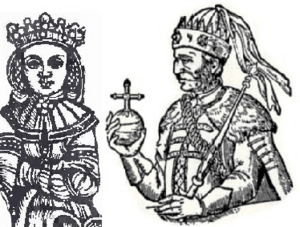Anna of Cilli facts for kids
Quick facts for kids Anna of Cilli |
|
|---|---|

Anna with Jogaila
|
|
| Queen consort of Poland | |
| Tenure | 29 January 1402 – 21 May 1416 |
| Coronation | 25 February 1403 |
| Born | 1386 |
| Died | 21 May 1416 (aged 29–30) Kraków, Poland |
| Burial | Wawel Cathedral |
| Spouse | Władysław II Jagiełło |
| Issue | Hedwig Jagiellon |
| House | Celje |
| Father | William, Count of Celje |
| Mother | Anna of Poland |
Anna of Cilli (also known as Anne of Celje) was the Queen consort of Poland from 1402 to 1416. She was born in 1386 and passed away on May 21, 1416. Anna was the second wife of Jogaila, who was the King of Poland and the Grand Duke of Lithuania. Their marriage was important for political reasons. It helped King Jogaila strengthen his connection to the Piast family, which was a powerful Polish royal family. This connection also made his claim to the Polish throne stronger. Anna and Jogaila had one daughter named Hedwig.
Early Life of Queen Anna
Anna was the only child of William, Count of Celje. Her mother was Anna of Poland, who was the youngest daughter of the late Polish king, Casimir III of Poland. Anna was likely born in Celje Castle, which is now in Slovenia. Her father, William, and his cousin, Herman II, Count of Celje, ruled this area together.
When Anna was about ten years old, her father passed away. Two years later, her mother remarried and left Anna in the care of Herman II and his wife. Anna grew up in Celje. It is believed that she did not know how to read or write, and she probably did not speak Polish at that time.
Her Royal Marriage
King Jogaila's first wife, Queen Jadwiga of Poland, died in 1399. She was Anna's second cousin. After Queen Jadwiga's death, Jogaila, who was from Lithuania, needed an heir to the throne. He also wanted to strengthen his position as King of Poland. So, he looked for a new wife from the Piast family, who had a strong claim to the Polish crown.
In 1401, King Jogaila sent people to Celje to ask for Anna's hand in marriage. Anna's family, the House of Celje, was related to the Polish royal family. This marriage would help create a stronger alliance between their families and raise the Celje family's status in Europe.
Anna arrived in Kraków on July 16, 1401. King Jogaila met her at the city gates. However, it is said that Jogaila did not like her much at first. The wedding was delayed because Anna needed to learn Polish. Anna stayed in a monastery while Jogaila traveled. He returned in January 1402. The wedding took place on January 29, 1402, in Wawel Cathedral. Anna's coronation as Queen of Poland happened later, on February 25, 1403.
Life as Queen
Life as Queen was not always easy for Anna. There was about a thirty-year age difference between her and King Jogaila. Anna was known for being a religious woman and an obedient wife. She was not very interested in politics. The King often traveled, leaving Anna alone at Wawel Castle.
In 1407, there were some false accusations against Queen Anna. However, Polish nobles defended her, and the accusations were dismissed. Later, in 1408, Anna gave birth to a daughter, Hedwig. Even though it was not a son, having a child strengthened Anna's position as Queen. She became a bit more involved in royal events.
In February 1410, during the Polish–Lithuanian–Teutonic War, Anna was present when King Jogaila met with her uncle, Herman II. After the important Battle of Grunwald, Jogaila wrote letters to Anna and a bishop. In 1412, Anna and Jogaila hosted a royal wedding. After the wedding, they traveled to Hungary for talks between Jogaila and Sigismund von Luxembourg. Anna met with Barbara of Cilli, Sigismund's wife, who was also Herman II's daughter. Anna and Barbara had grown up together.
In early 1413, Anna's five-year-old daughter, Hedwig, was officially named the next in line to the Polish throne. This was a big political win for Anna. Anna, Jogaila, and Hedwig traveled to Lithuania to introduce the princess to the Lithuanian nobles. The Union of Horodło was signed there in October 1413. Anna also visited Samogitia to see how Christianity was spreading. She later sent a report about it to the Council of Constance. In 1415, Anna traveled with Jogaila and met with Alexander I of Moldavia. This was her last known political action.
Death of Queen Anna
Towards the end of 1415, King Jogaila traveled to Lithuania. Anna stayed in Kraków, perhaps because she was already feeling unwell. In February 1416, a message was sent to Jogaila saying that the Queen was very ill. Despite the news, Jogaila did not rush back to Kraków. He only reached the capital city in May. Queen Anna passed away a few days later. She was buried in Wawel Cathedral.

